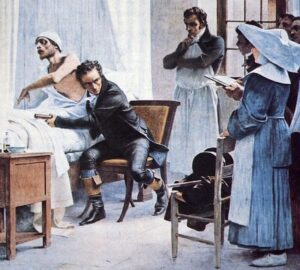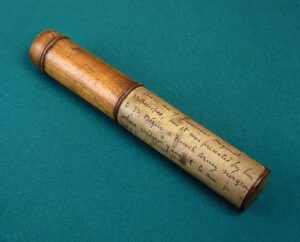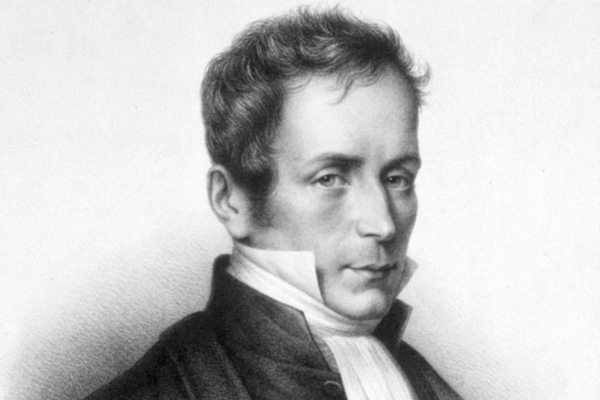The invention of the stethoscope
Before the stethoscope was invented, doctors often had to place their ear and head directly on the patient’s chest to listen to the heartbeat. This method was challenging, especially for obese individuals, and was highly sensitive and uncomfortable for young women.
In the early 19th century, Dr. René Laënnec encountered two children sending signals to each other using a hollow wooden stick. This inspired him to invent the stethoscope. On a beautiful September morning in 1816, French physician René Theophile Hyacinthe Laënnec, then 35 years old, was strolling through the courtyard of the Le Louvre Palace in Paris when he saw two children sending signals to each other through a hollow wooden stick. One child tapped on one end of the stick while the other listened at the opposite end.
Later that year, Dr. Laënnec treated a young woman with heart problems. Initially, he used his fingers to tap on her chest for diagnosis. Embarrassed about placing his ear directly on her chest, he rolled a piece of paper into a tube and placed it on her chest. To his surprise, the rolled paper amplified the heart sounds without physical contact, allowing him to diagnose accurately and hear the heartbeat clearly.
Development of the Stethoscope
This breakthrough led to the invention of the first stethoscope, made from a wooden tube. Laënnec spent the next three years experimenting with different materials to create the stethoscope. Ultimately, he perfected the design with a wooden tube, 3.5 cm in diameter and 25 cm in length, for examining patients’ chest health.
After many successful diagnoses of heart and lung sounds, the stethoscope was also used in autopsies. Laënnec published the first study on body sounds, earning recognition as the father of clinical diagnosis. He wrote the first descriptions of bronchiectasis and cirrhosis, and classified lung conditions such as pneumonia, bronchiectasis, pleurisy, emphysema, pneumothorax, and other lung diseases with his invention.
Clinical Terminology
Dr. Laënnec introduced many clinical terms related to the stethoscope that are still used today. Born in Quimper, Brittany, France, in 1781, Laënnec lost his mother to tuberculosis at age five and lived with his uncle, the dean of a university medical school. As a child, Laënnec suffered from poor health, slow physical development, frequent stomachaches, and severe coughing fits. He found solace in music, spending his free time playing the flute and writing poetry.
Medical Career
Inspired by his uncle, Laënnec pursued a medical career. At age 14, in 1795, he helped care for the sick and wounded at the Hotel Dieu in Nantes. By 18, he served in the Military Hospital as a third-class surgeon, becoming familiar with clinical work, major surgeries, and patient treatment. Within a year, Laënnec won his first awards in both medicine and surgery at medical school. In 1802, he published his first paper on topics such as peritonitis, amenorrhea, and liver disease, gaining recognition and beginning his exploration of human anatomy and pathological research.
Final Days
In his final months, Laënnec asked his nephew, Meriadec, to stimulate his chest and describe what he heard with the stethoscope. He died of pulmonary tuberculosis, the very disease he had illuminated with his stethoscope. In his will, Laënnec left his nephew all his medical research, along with the wooden stethoscope, his most valuable possession.
The wooden stethoscope was used until the late 19th century, after which it underwent many improvements and became increasingly popular. Today, rubber stethoscopes are commonly used, allowing doctors to hear low and high-frequency body sounds.
Medically, the stethoscope is a simple application of one of the most basic physical laws: sound conduction and amplification. However, it has had a profound impact and become a symbol of modern medicine. Initially intended to create distance between doctor and patient, the stethoscope has become an iconic tool for doctors and invaluable in patient care.

